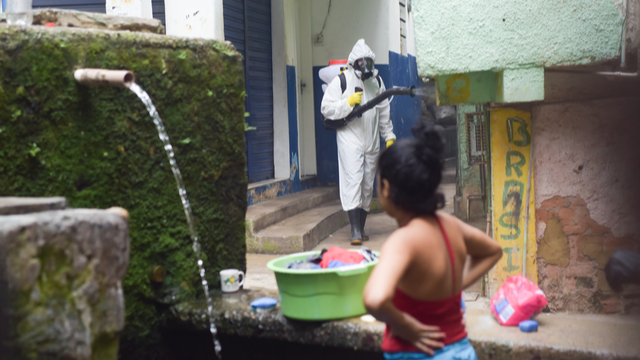April 27, 2021
Niche and local geography shape the pangenome of wastewater- and livestock-associated Enterobacteriaceae. Even though disease dynamics of natural populations can lead to antimicrobial resistance (AMR), most research on AMR focuses on clinical isolates. In this study, researchers in the UK analyzed the genomes of 827 Enterobacteriaceae collected from 19 locations, including livestock farms and wastewater treatment plants, at three time points over a year. The study showed that plasmids (circular pieces of bacterial DNA), were under stronger selective pressure (i.e., more likely to propagate in the population) and carried a high burden (48.0%) of the AMR genes identified in the study. This finding highlights the importance of understanding the spread of AMR genes in a ‘One Health’ context and promoting local strategies to combat it. [Science Advances]
Clarithromycin resistance is likely to decrease if macrolides were used only for H. pylori eradication. Researchers from Semmelweis University in Hungary led a retrospective observational study to determine the primary clarithromycin resistance (Cla-res) rate in a large cohort of Helicobacter pylori-infected patients. The study showed that Cla-res was found in 5.5% of macrolide-naive patients (primary Cla-res), and a mathematical model estimated that this primary Cla-res originated from the transmission of resistant bacteria in 98.7% of cases and spontaneous mutations in the other 1.3%. The association between age and gender among secondary (acquired) Cla-res infections was predominantly associated with macrolides’ prior use for non-eradication purposes, suggesting that Cla-res prevalence would likely decrease if macrolides were no longer used for purposes other than H.pylori eradication. [Nature]
Measles incidence and vaccination coverage in Nigeria varied geographically and annually between 2008 and 2018. Although WHO member countries aimed to eliminate measles by 2020, progress has been stymied by persistently low vaccination rates in many countries and regions. Analysis of population-based surveys in Nigeria revealed that the incidence of measles varied from 9.8 per million population in 2009 to 320.39 per million in 2013. MCV1 coverage in the north (45.5%) was lower than the country’s average (54.0%), while incidence rates (70.6 per million) were much higher than in the south (17.8 percent). These findings highlight the need for national and regional approaches to increase the uptake of measles vaccines. [Vaccine]
A systematic review of LMICs finds a decrease in HPV vaccination in countries with high uptake and an increase in HPV vaccination in countries with low uptake. HPV is the second-leading cause of infection-attributable cancers worldwide, and HPV-attributable cancers have the highest incident rates in sub-Saharan Africa (19.3 cases per 100,000 person-years). A systematic review of HPV vaccination in low- and middle-income countries found approximately 62% of the target population in these countries was vaccinated against HPV during 2008-2020. However, in countries with high uptake, vaccination declined from 89.03% in 2006-2014 to 41.48% in 2015-2020. In contrast, vaccination increased from 0.76% to 5.22% over the same period in countries with low uptake. HPV vaccination in LMICs and particularly countries with low uptake should be encouraged to achieve target levels of cervical cancer reduction at the global scale. [EClinical Medicine]
Perceived Discrimination, Psychosocial Resources, and Mental Distress in Vietnamese Americans. Researchers from Tulane University and the University of Southern California analyzed data from the 2015 Asian American Quality of Life project to examine how the mental health of Vietnamese Americans is influenced by life stressors such as perceived discrimination and psychosocial resources such as social networks, religiosity, and acculturation. Approximately 32% of the Vietnamese American population included in the study reported having experienced perceived discrimination. This was associated with younger age, lower education, lower religiosity, and higher acculturation. Experience of discrimination was also associated with increased mental distress, even when adjusting for demographic, health, and immigration-related characteristics. [J of Mig and Health]
Socioeconomic vulnerability drove the course of the COVID-19 epidemic in Brazil. Researchers from Sao Paolo School of Business Administration in Brazil investigated the relationship between COVID-19 spread in Brazil and factors such as socioeconomic characteristics, healthcare resources, and government responses by developing a socioeconomic vulnerability index (SVI) based on publicly available sources. They revealed that the initial spread of COVID-19 was affected mainly by patterns of socioeconomic vulnerability rather than population age structure and prevalence of health risk factors, with death rates accelerating notably in municipalities with the highest SVIs. However, with time, local government responses and population behavior in areas with higher SVIs helped contain the epidemic’s effects leading to lower death rates than in regions with low SVIs. [The Lancet Global Health]
The easing of social distancing measures requires vaccination of at least half of the population. Researchers at the China-Australia Joint Research Center for Infectious Diseases developed a modified SEIR model to investigate the effectiveness of strategies to end the pandemic with the lowest loss of life. Using data from the Johns Hopkins Coronavirus resource center on four of the most affected US States, the study investigated the effectiveness of vaccine rollouts with different levels of continued non-pharmaceutical measures such as mask-wearing and social distancing. The findings suggested that mask use and social distancing are necessary measures as the population gets vaccinated and that social distancing measures can only be relaxed after at least half the population receives a moderately effective vaccine (80% effective). (Vaccine)
Energy-demanding interventions can lead to cost savings by reducing hospital-acquired infections. Researchers at Johns Hopkins University and CDDEP conducted a modeling study in which they assessed the energy demand and economic cost of two infection control measures, negative pressure (NP) ventilation and xenon pulsed ultraviolet (XP-UV) equipment used to disinfect rooms, in hospitals of different sizes and based on increases in COVID-19 hospitalizations. The study revealed that if implemented early in the pandemic, the interventions could lead to a 77% reduction in secondary COVID-19 infections, and those overall cost savings were realized within six to eight weeks by hospitals of different sizes and with different power demands. [Energy & Buildings]
Throat swabs offer low diagnostic accuracy for SARS-CoV-2 detection. Researchers at the WHO Collaborating Centre for Infectious Disease Epidemiology and Control at the University of Hong Kong conducted a systematic review and meta-analysis to examine the performance of nasopharyngeal swabs and other specimens for the diagnosis of SARS-CoV-2 infection. The study revealed that pooled nasal and throat swabs were comparable to the gold standard of nasopharyngeal swabs with a sensitivity of 97%, whereas saliva and nasal swabs showed sensitivities of 85% and 86%, respectively. Despite limitations, pooled nasal and throat swabs, saliva, and nasal swabs could represent alternative sampling methods for SARS-CoV-2 RNA detection in community settings, especially since self-collection methods for pooled nasal and throat swabs and nasal swabs did not impair diagnostic accuracy. [The Lancet Infectious Diseases]
Photo: Shutterstock













